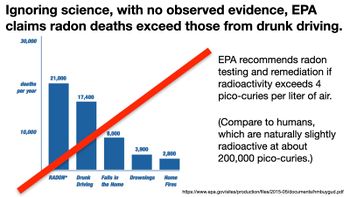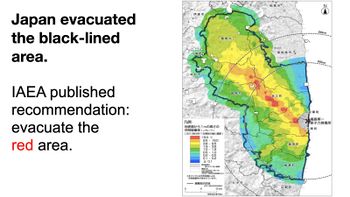Fear of radiation: Difference between revisions
(clarify references, add quotes) |
(add more quoted text) |
||
| Line 9: | Line 9: | ||
Over-reliance on the LNT model has led to policies that are very costly, like radon remediation in old homes (Fig.4) and over-reaction to radiation accidents, like the evacuation after Fukushima (Fig.5), which caused far more deaths than the accident itself (Fig.6). It has also led to excessive fear of radiation from medical x-rays and other nuclear medicine procedures which save thousands of lives. | Over-reliance on the LNT model has led to policies that are very costly, like radon remediation in old homes (Fig.4) and over-reaction to radiation accidents, like the evacuation after Fukushima (Fig.5), which caused far more deaths than the accident itself (Fig.6). It has also led to excessive fear of radiation from medical x-rays and other nuclear medicine procedures which save thousands of lives. | ||
{{Image|Electrify5Radiophobia.014.jpeg|right|350px|Fig.5 Evacuation following the Fukushima meltdown.}} | {{Image|Electrify5Radiophobia.014.jpeg|right|350px|Fig.5 Evacuation following the Fukushima meltdown.}} | ||
{{Image|Fukushima 28000.jpeg|right|350px|Fig.6 Fukushima death toll over seven years, mostly from the tsunami, some from fear, none from radiation.<ref>[https://www.sciencedirect.com/science/article/pii/S0301421519303611 | {{Image|Fukushima 28000.jpeg|right|350px|Fig.6 Fukushima death toll over seven years, mostly from the tsunami, some from fear, none from radiation.<ref>[https://www.sciencedirect.com/science/article/pii/S0301421519303611 Kharecha 2019] "Implications of energy and CO2 emission changes in Japan and Germany after the Fukushima accident", Pushker Kharecha, Makiko Sato, Science Direct, Volume 132, September 2019, Pages 647-653, https://doi.org/10.1016/j.enpol.2019.05.057</ref>}} | ||
The LNT model has also been used to argue against expansion of nuclear power. It has lead to the belief that an accident causing a small increase in radiation over a very large area could lead to a large number of cancers and deaths. A more realistic assessment will show that the danger from nuclear power is much smaller than the public believes, and much smaller than the risks from ever-increasing CO2 in our atmosphere. | The LNT model has also been used to argue against expansion of nuclear power. It has lead to the belief that an accident causing a small increase in radiation over a very large area could lead to a large number of cancers and deaths. A more realistic assessment will show that the danger from nuclear power is much smaller than the public believes, and much smaller than the risks from ever-increasing CO2 in our atmosphere. | ||
| Line 15: | Line 15: | ||
=Further Reading= | =Further Reading= | ||
For the pro-LNT point of view, see ''Hold Fast to Linear No-Threshold for Radiation Protection'', Bemnet Alemayehu, Senior Staff Scientist, Natural Resources Defense Council, 2016.<ref>[https://www.nrdc.org/experts/bemnet-alemayehu/hold-fast-linear-no-threshold-radiation-protection Hold Fast to Linear No-Threshold for Radiation Protection], Bemnet Alemayehu, Natural Resources Defense Council, 2016; last access | For the pro-LNT point of view, see ''Hold Fast to Linear No-Threshold for Radiation Protection'', Bemnet Alemayehu, Senior Staff Scientist, Natural Resources Defense Council, 2016.<ref>[https://www.nrdc.org/experts/bemnet-alemayehu/hold-fast-linear-no-threshold-radiation-protection Hold Fast to Linear No-Threshold for Radiation Protection], Bemnet Alemayehu, Natural Resources Defense Council, 2016; last access 9/9/2024.</ref><br> | ||
"... numerous authoritative national and international bodies have convened committees of experts to examine the issue of LNT | "... numerous authoritative national and international bodies have convened committees of experts to examine the issue of LNT ... Again and again, these bodies have endorsed LNT as a reasonable approach to regulating exposures to low dose radiation. ... Opponents of the LNT model simply chose to disregard core research and findings in the field of radiation health physics." | ||
For a rebuttal to these arguments from authority, and an in-depth review of the history, politics, and science of LNT, see ''Epidemiology Without Biology: False Paradigms, Unfounded Assumptions, and Specious Statistics in Radiation Science'', Bill Sacks, Gregory Meyerson & Jeffry A. Siegel, | For a rebuttal to these arguments from authority, and an in-depth review of the history, politics, and science of LNT, see ''Epidemiology Without Biology: False Paradigms, Unfounded Assumptions, and Specious Statistics in Radiation Science'', Bill Sacks, Gregory Meyerson & Jeffry A. Siegel, | ||
Revision as of 02:32, 9 September 2024
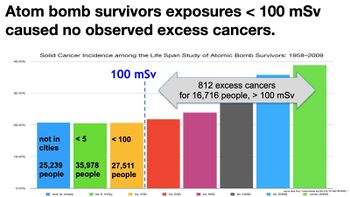
Fig.1 Exposures up to 100mSv in a short time won't overwhelm our immune systems.[1]
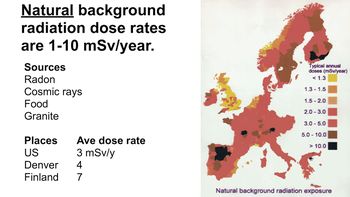
Fear of radiation is one of the barriers to reconsidering nuclear power. Government agencies have for decades assumed that deaths and other bad effects of radiation on our health follow a model called Linear No Threshold (LNT), in which death and disease is directly proportional to the total cumulative radiation, no matter how low the rate, even as low as the normal background radiation from space and the materials around us. This assumption ignores the data on low exposures (Figs.1&2) and the role of DNA repair in mitigating the damage done by low doses of radiation (Fig.3). Without a repair mechanism, the number of DNA breaks would simply accumulate in a linear fashion, no matter how low the exposure.

Fig.3 Natural breakage and repair of our DNA occurs much faster than damage from low levels of radiation.[3]
Over-reliance on the LNT model has led to policies that are very costly, like radon remediation in old homes (Fig.4) and over-reaction to radiation accidents, like the evacuation after Fukushima (Fig.5), which caused far more deaths than the accident itself (Fig.6). It has also led to excessive fear of radiation from medical x-rays and other nuclear medicine procedures which save thousands of lives.
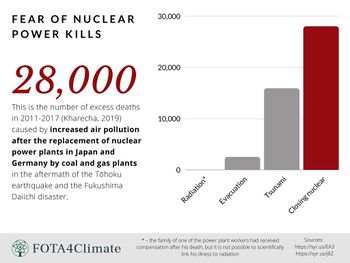
The LNT model has also been used to argue against expansion of nuclear power. It has lead to the belief that an accident causing a small increase in radiation over a very large area could lead to a large number of cancers and deaths. A more realistic assessment will show that the danger from nuclear power is much smaller than the public believes, and much smaller than the risks from ever-increasing CO2 in our atmosphere.
Further Reading
For the pro-LNT point of view, see Hold Fast to Linear No-Threshold for Radiation Protection, Bemnet Alemayehu, Senior Staff Scientist, Natural Resources Defense Council, 2016.[5]
"... numerous authoritative national and international bodies have convened committees of experts to examine the issue of LNT ... Again and again, these bodies have endorsed LNT as a reasonable approach to regulating exposures to low dose radiation. ... Opponents of the LNT model simply chose to disregard core research and findings in the field of radiation health physics."
For a rebuttal to these arguments from authority, and an in-depth review of the history, politics, and science of LNT, see Epidemiology Without Biology: False Paradigms, Unfounded Assumptions, and Specious Statistics in Radiation Science, Bill Sacks, Gregory Meyerson & Jeffry A. Siegel,
Biological Theory, 2016.[6]
"Belief in LNT informs the practice of radiology, radiation regulatory policies, and popular culture through the media. The result is mass radiophobia and harmful outcomes, including forced relocations of populations near nuclear power plant accidents, reluctance to avail oneself of needed medical imaging studies, and aversion to nuclear energy — all unwarranted and all harmful to millions of people."
Notes and References
- ↑ Grant 2017 "Solid Cancer Incidence among Atomic Bomb Survivors: 1958–2009" E.J.Grant, et.al., Radiation Research, 187(5):513-537 (2017), see Table 3 for data.
- ↑ Map of natural background radiation
- ↑ https://en.wikipedia.org/wiki/DNA_repair
- ↑ Kharecha 2019 "Implications of energy and CO2 emission changes in Japan and Germany after the Fukushima accident", Pushker Kharecha, Makiko Sato, Science Direct, Volume 132, September 2019, Pages 647-653, https://doi.org/10.1016/j.enpol.2019.05.057
- ↑ Hold Fast to Linear No-Threshold for Radiation Protection, Bemnet Alemayehu, Natural Resources Defense Council, 2016; last access 9/9/2024.
- ↑ Sacks, B., Meyerson, G. & Siegel, J.A., Biol Theory 11, 69–101 (2016). https://doi.org/10.1007/s13752-016-0244-4
